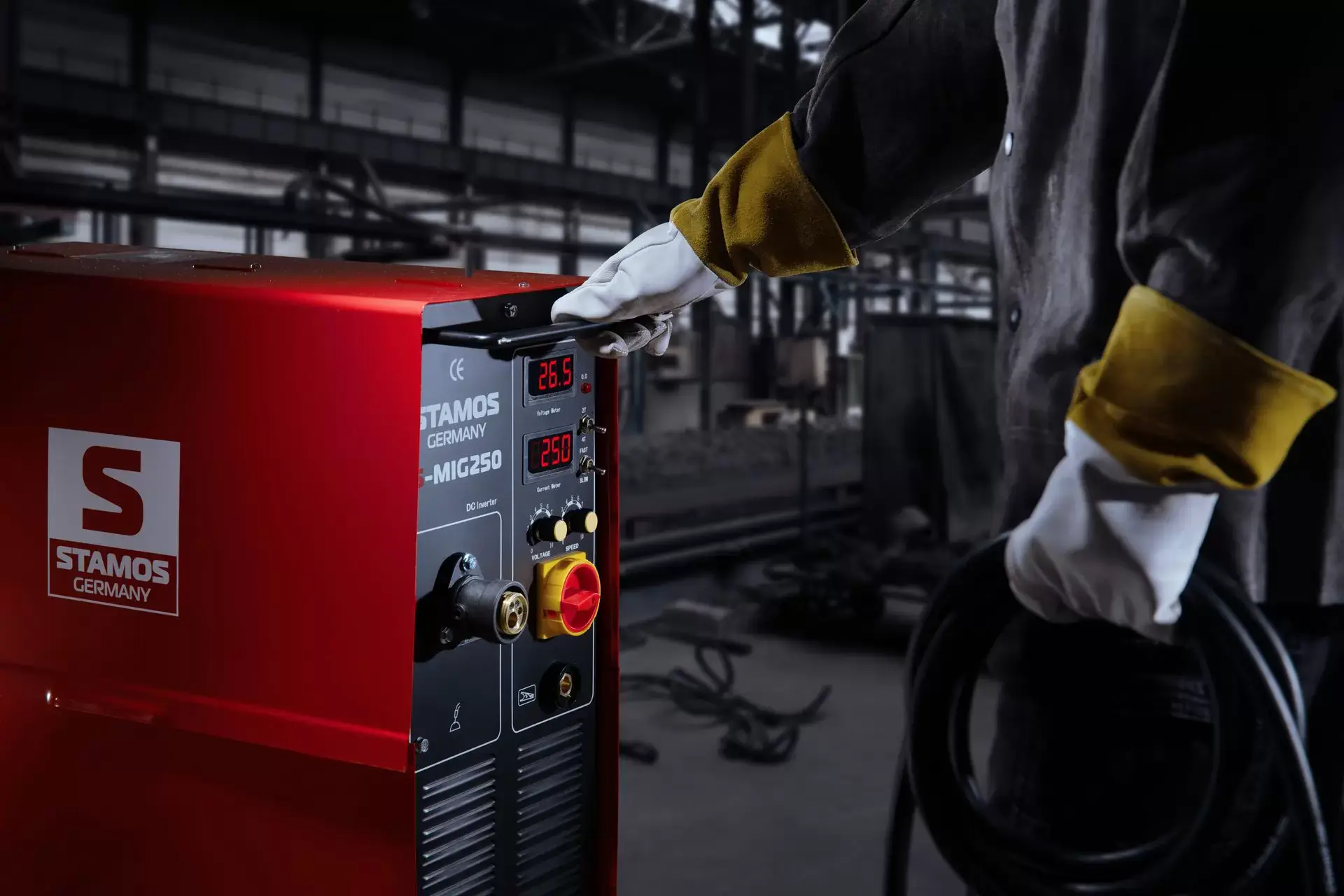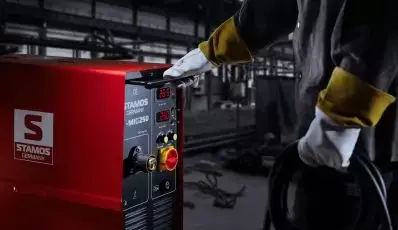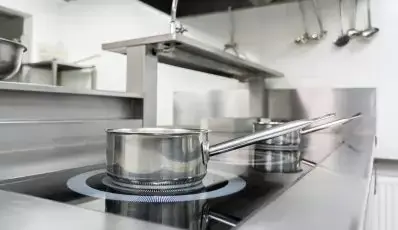Choosing the right welding machine can be tricky for beginners, with many different models to choose from, differing not only in price, but also features and methods of use. Welding machines can also be divided according to their technological features, i.e. inverter or transformer welding machines. But what are their features? And how do they differ from each other? Let's take a closer look.

Choosing the right welding machine can be tricky for beginners, with many different models to choose from, differing not only in price, but also features and methods of use. Welding machines can also be divided according to their technological features, i.e. inverter or transformer welding machines. But what are their features? And how do they differ from each other? Let’s take a closer look.
Inverter welding machines
This type is now pretty standard in the welding industry. The inverter welder is a modern machine with a technologically advanced electronic system, with the task of increasing the frequency of the electric current from the network and converting it into a current suitable for welding. This is, of course, only a general overview, because the whole process takes place in several stages.
First of all, the AC voltage from the network is filtered and rectified. The inverter then changes it back to AC, but significantly increases its frequency. This allows the user to determine the exact parameters of the welding machine at any given moment. In the next step, the voltage is directed to the transformer, where it is lowered again to a level enabling the arc to ignite. This allows you to set the welding current with a precision of 1A, which is perfect for bonding smaller elements.
Due to their design, inverter welding machines are usually small and relatively light, which makes them very mobile. Thus, they are perfect using on the move or when you need to change the welding position.
Inverter welders also have the advantage that they can be connected to standard 230V voltage plug sockets found in every household. For this reason, inverter welding machines are popular with professional welders and amateurs alike.
Inverter welders also have a number of useful functions that make much easier to use. The exact list of functions depends on the specific model.
Thanks to the use of electronic systems, inverter welding machines are also resistant to voltage surges. They can be used with power generators, and can also be connected to a long extension cable. The generated arc is stable, which guarantees precise and clean welds.
Inverter welders also use relatively little electricity. In addition to using less energy, this also means that they do not overheat. This makes them both economical and efficient, ensuring a work cycle of 60 – 100%.
They are generally very reliable pieces of equipment. However, this does not mean that they never break down, and when they do, repairs can be quite expensive. In addition, inverter welders are susceptible to weather conditions, and also prone to mechanically damage. Therefore, caution is recommended during use, which is by far the biggest disadvantage of this type of welder.
-
Welding Set Plasma Cutter – 80 A – 400 V + Welding helmet – Carbonic – PROFESSIONAL SERIES
-
Welding Set Plasma Cutter – 90 A – 400 V – Pilot Ignition + Welding helmet – Carbonic – PROFESSIONAL SERIES
-
Welding Set Plasma Cutter – 85 A – 400 V – Pilot Ignition + Welding helmet – Carbonic – PROFESSIONAL SERIES
-
TIG Welder Set – 200 A – IGBT + welding helmet LEGEND + welding gloves
Transformer welding machines
The second type are transformer welders. They have a very simple design, making them relatively cheap and therefore more popular with amateurs who need a welder for private use. Due to the limited number of complicated components, they are easy to repair in the event of any technical failures.
The large transformer means that this type of machine tends to heat up quite quickly. Short but frequent breaks are therefore necessary in order to cool the device down. The work cycle in this case ranges from 25 to 35%, and transformer welders use an ampacity of 160A with 25A protection.
Transformer welders are also highly resistant to weather conditions and mechanical damage. They are therefore suitable for use in harsh working conditions and can be operated in low temperatures, as well as places with high dust levels and even humidity.
Transformer welding machines are also usually very large, and are therefore usually used as stationary devices. Special trolleys are used to transport them, due to their excessive weight. According to some opinions transformer welders won’t let you make good quality welds. However, the quality of the weld in this case depends on the quality of the electrodes and the experience of the welder.
Differences between inverter and transformer welding machines
With basic knowledge of the main features of each type of welding machine, identifying the differences between an inverter and a transformer welder is relatively easy. The first difference, noticeable at first glance, are their dimensions. Transformer welders are much larger and therefore less mobile than welding machines equipped with an inverter.
The second difference is in the design. Transformer welding machines are significantly less technologically complex than inverter welding machines that use advanced electronic systems. As a result, the latter allow you to set a more precise welding current, and also offer a number of very useful functions making it easier to weld.
Another difference between inverter and transformer welding machines is their resistance to mechanical damage and weather conditions, such as temperature differences, air humidity or dust. Transformer welders are much better in these cases. Unlike inverter welding machines, they cover all of these features. In addition, in the event of a failure, repairing transformer welding machines is much simpler and cheaper.
The fourth difference worth mentioning is the work cycle. In the case of transformer welders, it is between 25 and 35%, while inverter welders offer a work cycle in the range of 60 to even 100%. This is due to the fact that inverter welders do not overheat during use, letting you weld for a long time without stopping. With transformer welding machines, appropriate work planning is necessary in order to frequently cool the machine, as this type of machine heats up very quickly.
The last difference, but equally important, is the price. Inverter welders are much more expensive than transformer welding machines. Due to this, the latter are more popular with amateur welders, who only plan to use them for private purposes.
Inverter or transformer welding machine? Summary
Your choice of welding machine should depend not only on your budget, but also on the type and frequency of work you plan to perform. With a wide range of welding machines at your disposal, you can choose an inverter welder with all the latest technological solutions, or a traditional transformer welder. The first type offers a number of useful options to make your work easier, but is more prone to various types of mechanical and weather damage.
The second type, i.e. transformer welding machines, are more simple but at the same time more robust, and also cheaper to repair in the event of any technical issues. So consider all the differences and confront them with your own needs before making your final choice.
-
Welding Set Plasma Cutter – 60 A – 400 V + Welding helmet – Carbonic – PROFESSIONAL SERIES
-
Welding Set Plasma Cutter – 55 A – 230 V + Welding helmet – Firestarter 500 – ADVANCED SERIES
-
Welding Set Plasma Cutter – 50 A – 230 V – Basic + Welding helmet – Firestarter 500 – ADVANCED SERIES
-
Welding Set Plasma Cutter – 50 A – 230 V – Basic + Welding helmet – Eagle Eye – ADVANCED SERIES






Share